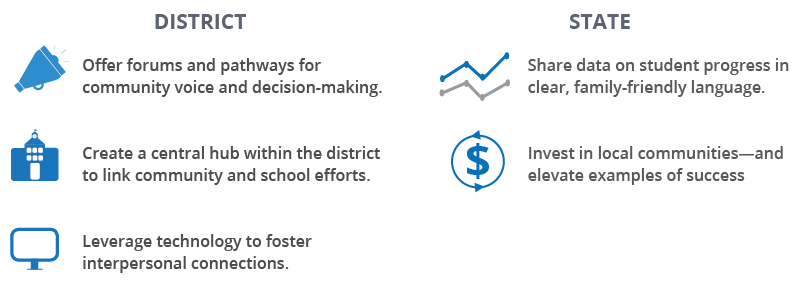A key piece of our Condition of Education in the Commonwealth report, the Action Guide provides research-informed recommendations for statewide actions—policies, investments, and expansion of best practices—that have potential to address performance gaps and contribute to broad improvement in student outcomes. In our recent Condition of Education Action Guides, we've called on the Commonwealth to consider education more holistically, noting that education encompasses more than academic learning.
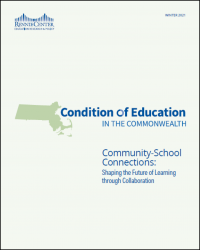 2021 Action Guide | Community-School Connections: Shaping the Future of Learning through Collaboration
2021 Action Guide | Community-School Connections: Shaping the Future of Learning through Collaboration
This year's report examines the critical role community plays in education. Integrating learning that takes place inside and outside of school has always been a powerful strategy to support student success, but it gained special relevance this year, as school closures made family and community members integral parts of students’ daily learning. This report provides recommendations for how schools, families, and community organizations can build on their collaboration over the past year to work toward a more equitable approach to education.
A Time for Change
A year unlike any other, 2020 brought with it a global pandemic, rising political tensions, new movements for racial justice, and opportunities to reflect critically on the function and dysfunction of our societal systems. COVID-19 has exacerbated the inequities already present in our communities and highlighted the urgency of addressing these deep disparities.
While in the past we have highlighted reform strategies aimed at addressing racial inequities, we now realize that we cannot “improve” public education without addressing the underlying issues of systemic racism. Instead of promoting strategies for navigating an inherently inequitable system, we need to start thinking about dismantling and transforming that system itself. This year has brought us to a crossroads, and we know that when life goes back to “normal” after the pandemic, our schools can't go back to the status quo.
But schools can’t do this alone. Community-wide opportunities and challenges require community-wide solutions.
The pandemic and school closures forced down the barriers between schools and communities. Now, as we look to the future, how can we use those connections to create an education system that is more equitable and inclusive? This action guide looks at three key areas where schools and communities can continue to work together to transform education: holistic learning, shared leadership, and multiple pathways to careers.
Holistic Learning
The education system serves students with a wide range of abilities, interests, and lived experiences. A holistic approach to learning aims to understand and address the unique strengths and needs of each student, in order to help them achieve their full potential. Recognizing a community’s cultural wealth and the learning that takes place outside school is essential to gaining a complete picture of each student as an individual. In addition, schools and communities can work together to build on students’ strengths and address their needs through connections with relevant services.
What can it looks like?
- Uplift community cultural wealth
- Connect learning experiences inside and outside of the school
- Focus on whole child supports
Local Spotlight: Framingham Public Schools
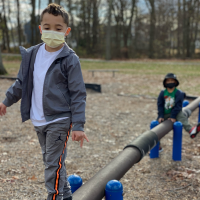 Framingham Public Schools works closely with community partners to offer high-quality out-of-school programming that enhances student development and achievement. The district also maintains strong connections with a range of community organizations and supports a culture of collaboration across partners to ensure equitable access to programming and other resources. District and school personnel meet with community partners monthly to design solutions to challenges they are facing and align the services they offer. When COVID-19 hit, Framingham relied on these strong, pre-existing community partnerships to help connect students and families with the support they needed.
Framingham Public Schools works closely with community partners to offer high-quality out-of-school programming that enhances student development and achievement. The district also maintains strong connections with a range of community organizations and supports a culture of collaboration across partners to ensure equitable access to programming and other resources. District and school personnel meet with community partners monthly to design solutions to challenges they are facing and align the services they offer. When COVID-19 hit, Framingham relied on these strong, pre-existing community partnerships to help connect students and families with the support they needed.
Shared Leadership
Serving all students equitably requires a commitment to incorporating diverse voices in educational decision-making. As a starting point, this means listening to and valuing a range of perspectives; at a deeper level, it means sharing power and expanding leadership opportunities to a broad array of stakeholders (particularly those most impacted by a decision). Consistently seeking input and feedback from students, parents, educators, and community members can lead to more inclusive and accessible processes, while resulting in higher-quality and better-aligned learning experiences for students.
What can it look like?
- Engaging student voice
- Engaging parent, caregiver, and family leadership
- Engaging community voice
Local Spotlight: Chelsea Public Schools
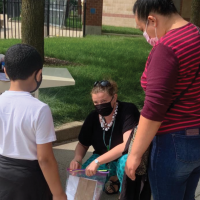 In Chelsea Public Schools, family and community engagement are viewed as crucial levers for advancing equity. With a predominantly Latino immigrant community and a majority White teaching staff, the district sought to remove barriers to effective communication and collaboration through a process of school improvement designed with families rather than for them. Through this Co-Design Pilot, families have been involved at every step of the improvement process. By building families into leadership positions to co-identify gaps and co-design solutions, Chelsea is deconstructing hierarchical power dynamics and building equitable and effective collaboration.
In Chelsea Public Schools, family and community engagement are viewed as crucial levers for advancing equity. With a predominantly Latino immigrant community and a majority White teaching staff, the district sought to remove barriers to effective communication and collaboration through a process of school improvement designed with families rather than for them. Through this Co-Design Pilot, families have been involved at every step of the improvement process. By building families into leadership positions to co-identify gaps and co-design solutions, Chelsea is deconstructing hierarchical power dynamics and building equitable and effective collaboration.
Multiple Pathways to Careers
Helping students develop the skills and competencies they need to enter the workforce is one of the core functions of the education system. Because every student has different talents, interests, and aspirations, the process of preparing students for a career should be equally individualized. Community members, community-based organizations, local businesses, and schools can all play critical roles in helping young people define and attain a career pathway, including by serving as a network of support as they navigate new experiences.
What can it look like?
- Two-generation approaches
- Experiential learning
Local Spotlight: Springfield WORKS
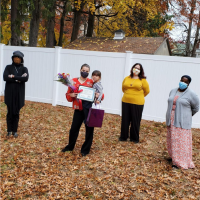 Springfield WORKS—a branch of the Western Massachusetts Economic Development Council—takes a two-generation approach to child and family development. The initiative supports parents whose children are enrolled in Head Start, which provides early childhood education, by helping them access career guidance and linking them with pathways to employment. Springfield WORKS partners include dozens of community organizations to connect participants with job training, career opportunities, internships, and mentoring.
Springfield WORKS—a branch of the Western Massachusetts Economic Development Council—takes a two-generation approach to child and family development. The initiative supports parents whose children are enrolled in Head Start, which provides early childhood education, by helping them access career guidance and linking them with pathways to employment. Springfield WORKS partners include dozens of community organizations to connect participants with job training, career opportunities, internships, and mentoring.
Policy Recommendations
